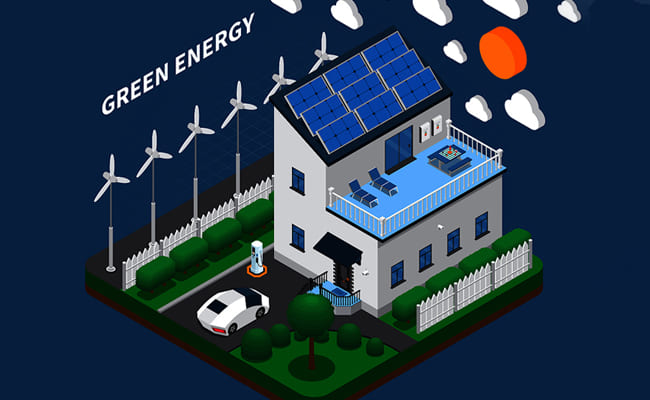As the global energy structure transforms and the demand for renewable energy grows, on grid wind turbines are becoming a key component of green energy. Efficiently and safely connecting these on grid wind turbines to the electrical grid maximizes wind energy utilization. The grid connection method impacts not only the stability of wind power generation but also the security of the power grid. This article explores on grid wind turbine connection technologies from two perspectives: grid connection method and voltage level.
I. Classification by Grid Connection Method
You can divide the grid connection method for on grid wind turbines into two main categories: asynchronous generators and synchronous generators. Based on the connection approach, wind power systems can also be classified as distributed grid connection and centralized grid connection.
1. Asynchronous Generator Grid Connection
The on grid wind turbine using asynchronous generators is one of the most common grid connection technologies. This method is simple and widely applied in small-scale wind power systems. The generator speed may differ slightly from the grid frequency, but the grid adjusts the speed for a successful connection.
-
Direct Grid Connection of Asynchronous Generators: When the wind-driven asynchronous generator’s speed approaches the synchronous speed, it can connect directly to the grid. This method is easy to implement but produces a large surge current, which may affect grid stability.
-
Step-down Grid Connection of Asynchronous Generators: To reduce the surge current during connection, engineers add resistors, reactors, or auto-transformers between the generator and the grid. This smooths the current and lessens the impact on the grid.
-
Soft Grid Connection of Asynchronous Generators: Power electronic devices finely control the voltage waveform, ensuring smooth current and voltage during connection. This method suits scenarios that require high grid quality.
2. Synchronous Generator Grid Connection
The on grid wind turbine using synchronous generators works perfectly in sync with the grid frequency, ensuring stable power output. While this method requires higher implementation costs, it guarantees better power quality and suits large-scale wind farms.
3. Distributed Grid Connection
Distributed on grid wind turbine systems are smaller in scale and suitable for residential areas, commercial districts, or small industrial zones. These systems typically connect to low or medium voltage grids, consisting of multiple small wind turbines. This setup allows local electricity consumption and reduces transmission losses.
-
Advantages: High flexibility, enables local generation and consumption of electricity, and limits the impact of system failures.
-
Applicable Scenarios: Small residential areas, commercial zones, and rural regions. It can also integrate with solar power and energy storage systems.
4. Centralized Grid Connection
Centralized on grid wind turbine systems are large in scale, typically used in wind farms or large wind projects. These systems connect to the high-voltage grid through a step-up substation, which suits large-scale power generation and long-distance transmission.
-
Advantages: Large-scale green power output, ideal for regions with abundant wind resources.
-
Disadvantages: Higher grid requirements, with increased construction and maintenance costs.
II. Classification by Voltage Level
You can also classify on grid wind turbine systems by voltage level, which affects the scale and type of connection. The three common voltage levels are:
1. Low Voltage Grid Connection (400V-690V)
Low-voltage grid connection suits small-scale distributed on grid wind turbines, typically used in residential areas, commercial zones, or small industrial users. These systems convert the on grid wind turbine’s output to AC suitable for low-voltage grids through an inverter.
-
Applicable Scenarios: Residential homes, commercial zones, industrial parks.
-
Features: Simple structure, easy installation, and ideal for areas with dispersed resources.
2. Medium Voltage Grid Connection (10kV-35kV)
Medium-voltage grid connection is used for medium-scale on grid wind turbines in wind farms, which connect to regional power grids. Engineers use step-up transformers to convert the on grid wind turbine’s low-voltage output to medium voltage, reducing transmission losses.
-
Applicable Scenarios: Medium-sized wind farms, industrial parks, rural areas.
-
Features: Relatively stable systems, ideal for combining multiple small-generation units.
3. High Voltage Grid Connection (110kV and above)
High-voltage grid connection is used for large-scale on grid wind turbines, transmitting power over long distances via high-voltage grids. This method is ideal for gathering wind power and delivering large amounts of electricity to distant locations.
-
Applicable Scenarios: Large wind farms, regional grid connections.
-
Features: Suitable for long-distance power transmission and provides high-efficiency green electricity output.
With continuous advancements in wind power technology, on grid wind turbine grid connection methods and voltage levels are becoming more diversified. When selecting a grid connection method for an on grid wind turbine, factors such as project scale, geographical location, and grid requirements need consideration. The combination of distributed and centralized grid connections ensures optimal on grid wind turbine integration in various regions and grid conditions.



